THEORIES, PRINCIPLES AND MODELS OF LEARNING IN EDUCATION
VerifiedAdded on 2022/02/14
|10
|2366
|90
AI Summary
To facilitate the learning process and minimise monotony, education offers a multitude of theories, principles, and methods. Between positive and negative reinforcement, there is a delicate line between rewards and punishments. Safeguarding and integrity must be applied in a straightforward manner in order to avoid ambiguity and the potential harm they may cause an individual. The individual will get an understanding of their own learning preferences and habits as well as ideas for adding more tactics after identifying their learning styles.
Contribute Materials
Your contribution can guide someone’s learning journey. Share your
documents today.
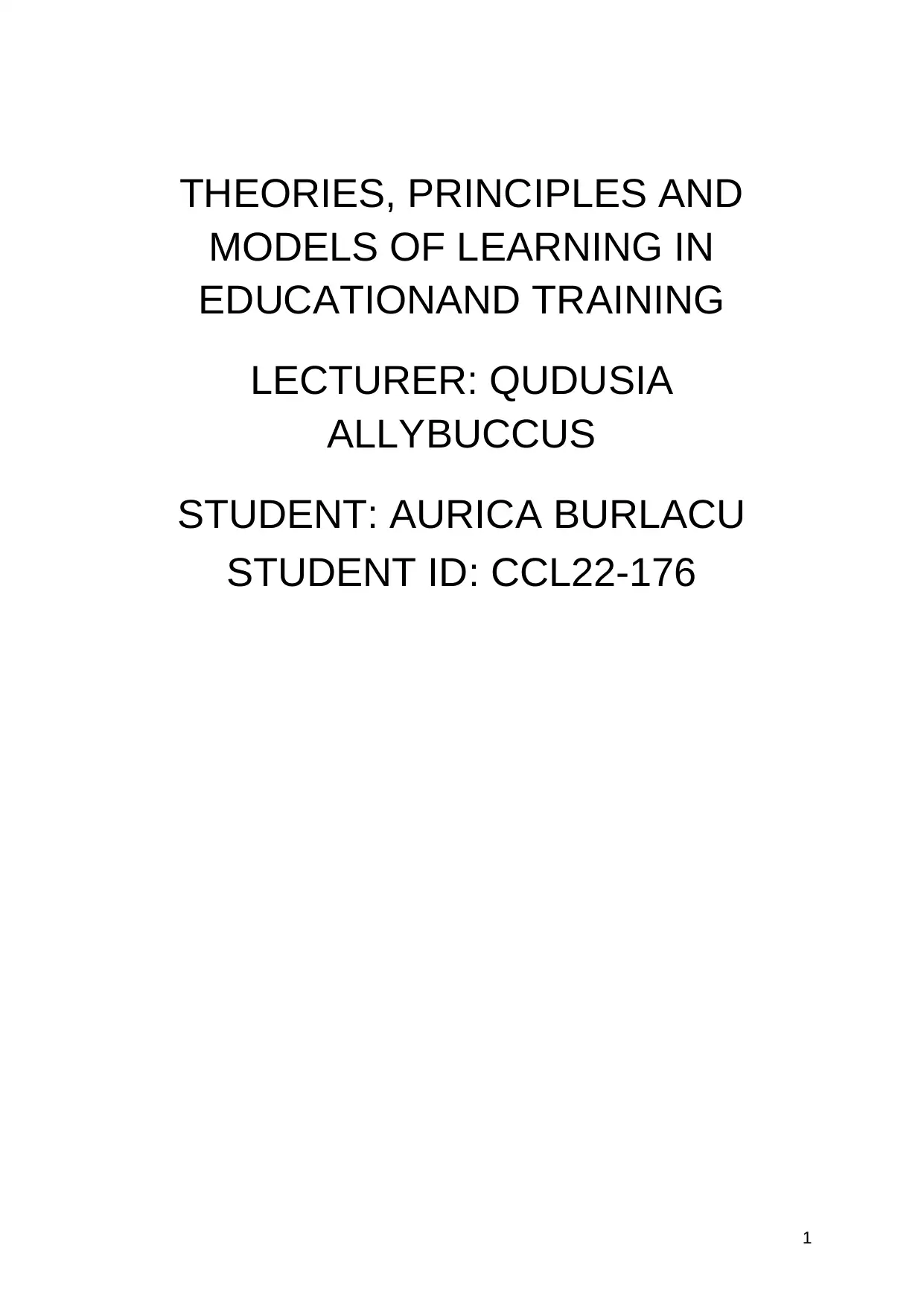
THEORIES, PRINCIPLES AND
MODELS OF LEARNING IN
EDUCATIONAND TRAINING
LECTURER: QUDUSIA
ALLYBUCCUS
STUDENT: AURICA BURLACU
STUDENT ID: CCL22-176
1
MODELS OF LEARNING IN
EDUCATIONAND TRAINING
LECTURER: QUDUSIA
ALLYBUCCUS
STUDENT: AURICA BURLACU
STUDENT ID: CCL22-176
1
Secure Best Marks with AI Grader
Need help grading? Try our AI Grader for instant feedback on your assignments.
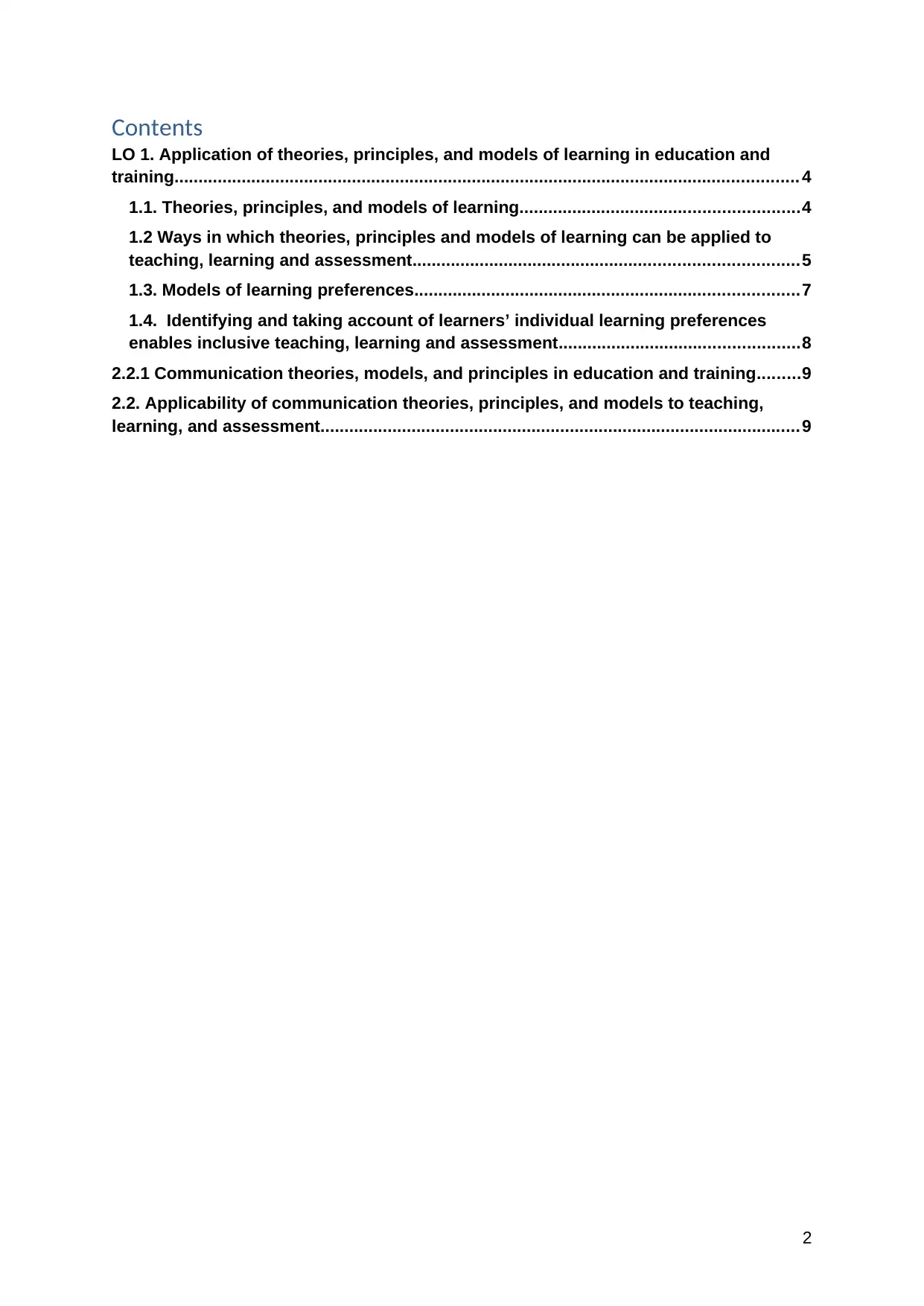
Contents
LO 1. Application of theories, principles, and models of learning in education and
training.................................................................................................................................. 4
1.1. Theories, principles, and models of learning..........................................................4
1.2 Ways in which theories, principles and models of learning can be applied to
teaching, learning and assessment................................................................................5
1.3. Models of learning preferences................................................................................7
1.4. Identifying and taking account of learners’ individual learning preferences
enables inclusive teaching, learning and assessment..................................................8
2.2.1 Communication theories, models, and principles in education and training.........9
2.2. Applicability of communication theories, principles, and models to teaching,
learning, and assessment....................................................................................................9
2
LO 1. Application of theories, principles, and models of learning in education and
training.................................................................................................................................. 4
1.1. Theories, principles, and models of learning..........................................................4
1.2 Ways in which theories, principles and models of learning can be applied to
teaching, learning and assessment................................................................................5
1.3. Models of learning preferences................................................................................7
1.4. Identifying and taking account of learners’ individual learning preferences
enables inclusive teaching, learning and assessment..................................................8
2.2.1 Communication theories, models, and principles in education and training.........9
2.2. Applicability of communication theories, principles, and models to teaching,
learning, and assessment....................................................................................................9
2
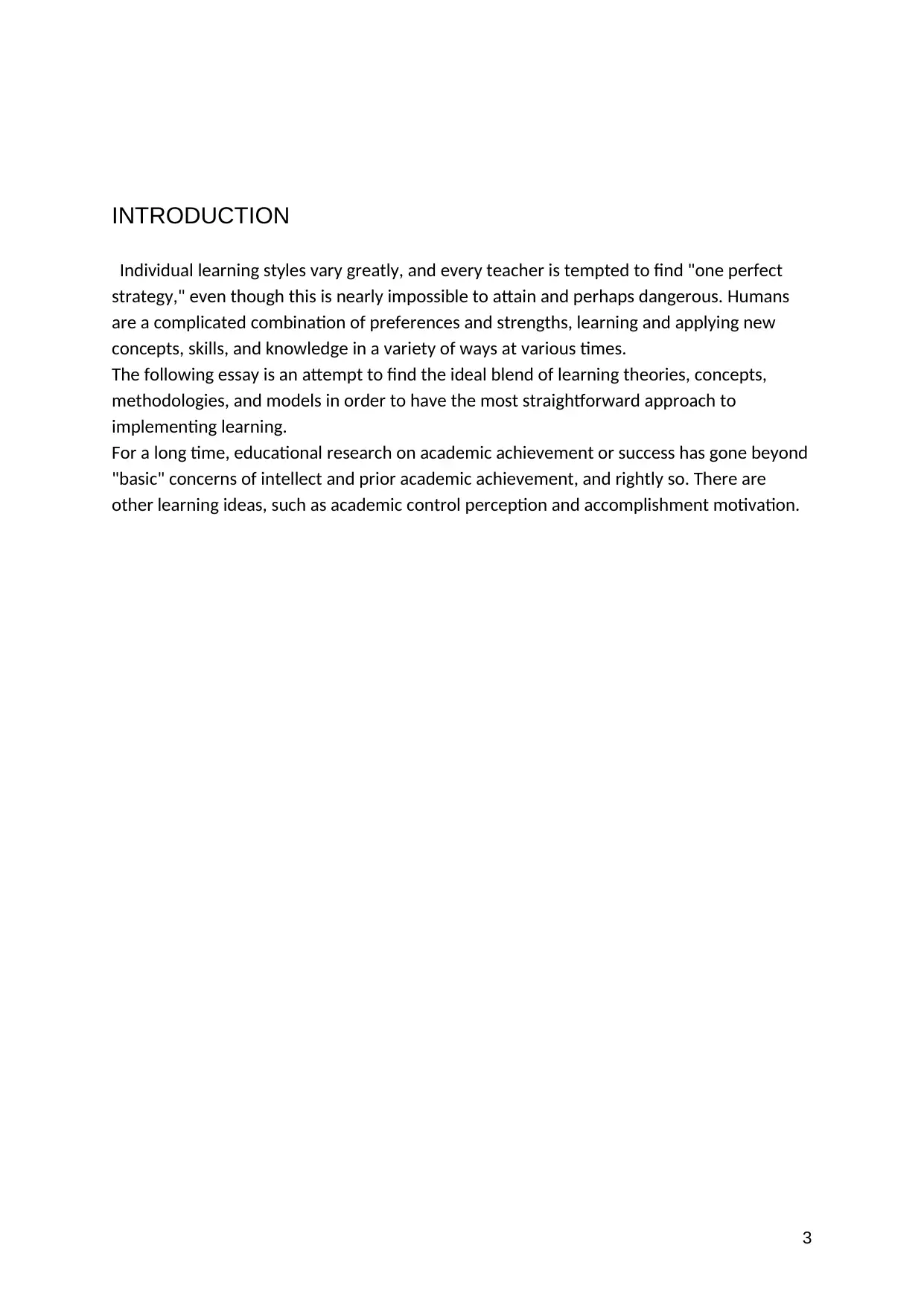
INTRODUCTION
“Individual learning styles vary greatly, and every teacher is tempted to find "one perfect
strategy," even though this is nearly impossible to attain and perhaps dangerous. Humans
are a complicated combination of preferences and strengths, learning and applying new
concepts, skills, and knowledge in a variety of ways at various times.”
The following essay is an attempt to find the ideal blend of learning theories, concepts,
methodologies, and models in order to have the most straightforward approach to
implementing learning.”
For a long time, educational research on academic achievement or success has gone beyond
"basic" concerns of intellect and prior academic achievement, and rightly so. There are
other learning ideas, such as academic control perception and accomplishment motivation.
3
“Individual learning styles vary greatly, and every teacher is tempted to find "one perfect
strategy," even though this is nearly impossible to attain and perhaps dangerous. Humans
are a complicated combination of preferences and strengths, learning and applying new
concepts, skills, and knowledge in a variety of ways at various times.”
The following essay is an attempt to find the ideal blend of learning theories, concepts,
methodologies, and models in order to have the most straightforward approach to
implementing learning.”
For a long time, educational research on academic achievement or success has gone beyond
"basic" concerns of intellect and prior academic achievement, and rightly so. There are
other learning ideas, such as academic control perception and accomplishment motivation.
3
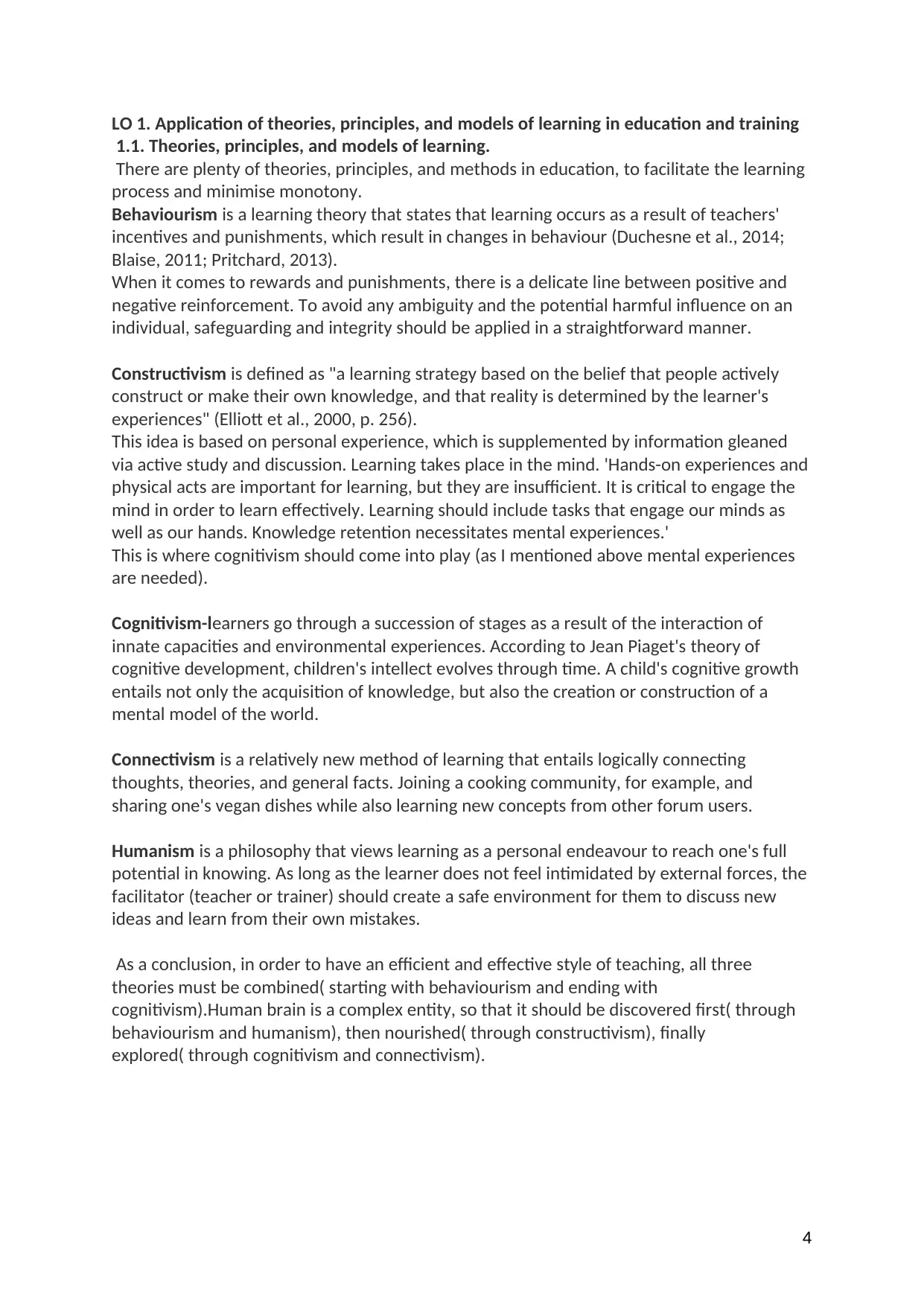
LO 1. Application of theories, principles, and models of learning in education and training
1.1. Theories, principles, and models of learning.
There are plenty of theories, principles, and methods in education, to facilitate the learning
process and minimise monotony.
Behaviourism is a learning theory that states that learning occurs as a result of teachers'
incentives and punishments, which result in changes in behaviour (Duchesne et al., 2014;
Blaise, 2011; Pritchard, 2013).
When it comes to rewards and punishments, there is a delicate line between positive and
negative reinforcement. To avoid any ambiguity and the potential harmful influence on an
individual, safeguarding and integrity should be applied in a straightforward manner.
Constructivism is defined as "a learning strategy based on the belief that people actively
construct or make their own knowledge, and that reality is determined by the learner's
experiences" (Elliott et al., 2000, p. 256).
This idea is based on personal experience, which is supplemented by information gleaned
via active study and discussion. Learning takes place in the mind. 'Hands-on experiences and
physical acts are important for learning, but they are insufficient. It is critical to engage the
mind in order to learn effectively. Learning should include tasks that engage our minds as
well as our hands. Knowledge retention necessitates mental experiences.'
This is where cognitivism should come into play (as I mentioned above mental experiences
are needed).
Cognitivism-learners go through a succession of stages as a result of the interaction of
innate capacities and environmental experiences. According to Jean Piaget's theory of
cognitive development, children's intellect evolves through time. A child's cognitive growth
entails not only the acquisition of knowledge, but also the creation or construction of a
mental model of the world.
Connectivism is a relatively new method of learning that entails logically connecting
thoughts, theories, and general facts. Joining a cooking community, for example, and
sharing one's vegan dishes while also learning new concepts from other forum users.
Humanism is a philosophy that views learning as a personal endeavour to reach one's full
potential in knowing. As long as the learner does not feel intimidated by external forces, the
facilitator (teacher or trainer) should create a safe environment for them to discuss new
ideas and learn from their own mistakes.
As a conclusion, in order to have an efficient and effective style of teaching, all three
theories must be combined( starting with behaviourism and ending with
cognitivism).Human brain is a complex entity, so that it should be discovered first( through
behaviourism and humanism), then nourished( through constructivism), finally
explored( through cognitivism and connectivism).
4
1.1. Theories, principles, and models of learning.
There are plenty of theories, principles, and methods in education, to facilitate the learning
process and minimise monotony.
Behaviourism is a learning theory that states that learning occurs as a result of teachers'
incentives and punishments, which result in changes in behaviour (Duchesne et al., 2014;
Blaise, 2011; Pritchard, 2013).
When it comes to rewards and punishments, there is a delicate line between positive and
negative reinforcement. To avoid any ambiguity and the potential harmful influence on an
individual, safeguarding and integrity should be applied in a straightforward manner.
Constructivism is defined as "a learning strategy based on the belief that people actively
construct or make their own knowledge, and that reality is determined by the learner's
experiences" (Elliott et al., 2000, p. 256).
This idea is based on personal experience, which is supplemented by information gleaned
via active study and discussion. Learning takes place in the mind. 'Hands-on experiences and
physical acts are important for learning, but they are insufficient. It is critical to engage the
mind in order to learn effectively. Learning should include tasks that engage our minds as
well as our hands. Knowledge retention necessitates mental experiences.'
This is where cognitivism should come into play (as I mentioned above mental experiences
are needed).
Cognitivism-learners go through a succession of stages as a result of the interaction of
innate capacities and environmental experiences. According to Jean Piaget's theory of
cognitive development, children's intellect evolves through time. A child's cognitive growth
entails not only the acquisition of knowledge, but also the creation or construction of a
mental model of the world.
Connectivism is a relatively new method of learning that entails logically connecting
thoughts, theories, and general facts. Joining a cooking community, for example, and
sharing one's vegan dishes while also learning new concepts from other forum users.
Humanism is a philosophy that views learning as a personal endeavour to reach one's full
potential in knowing. As long as the learner does not feel intimidated by external forces, the
facilitator (teacher or trainer) should create a safe environment for them to discuss new
ideas and learn from their own mistakes.
As a conclusion, in order to have an efficient and effective style of teaching, all three
theories must be combined( starting with behaviourism and ending with
cognitivism).Human brain is a complex entity, so that it should be discovered first( through
behaviourism and humanism), then nourished( through constructivism), finally
explored( through cognitivism and connectivism).
4
Secure Best Marks with AI Grader
Need help grading? Try our AI Grader for instant feedback on your assignments.
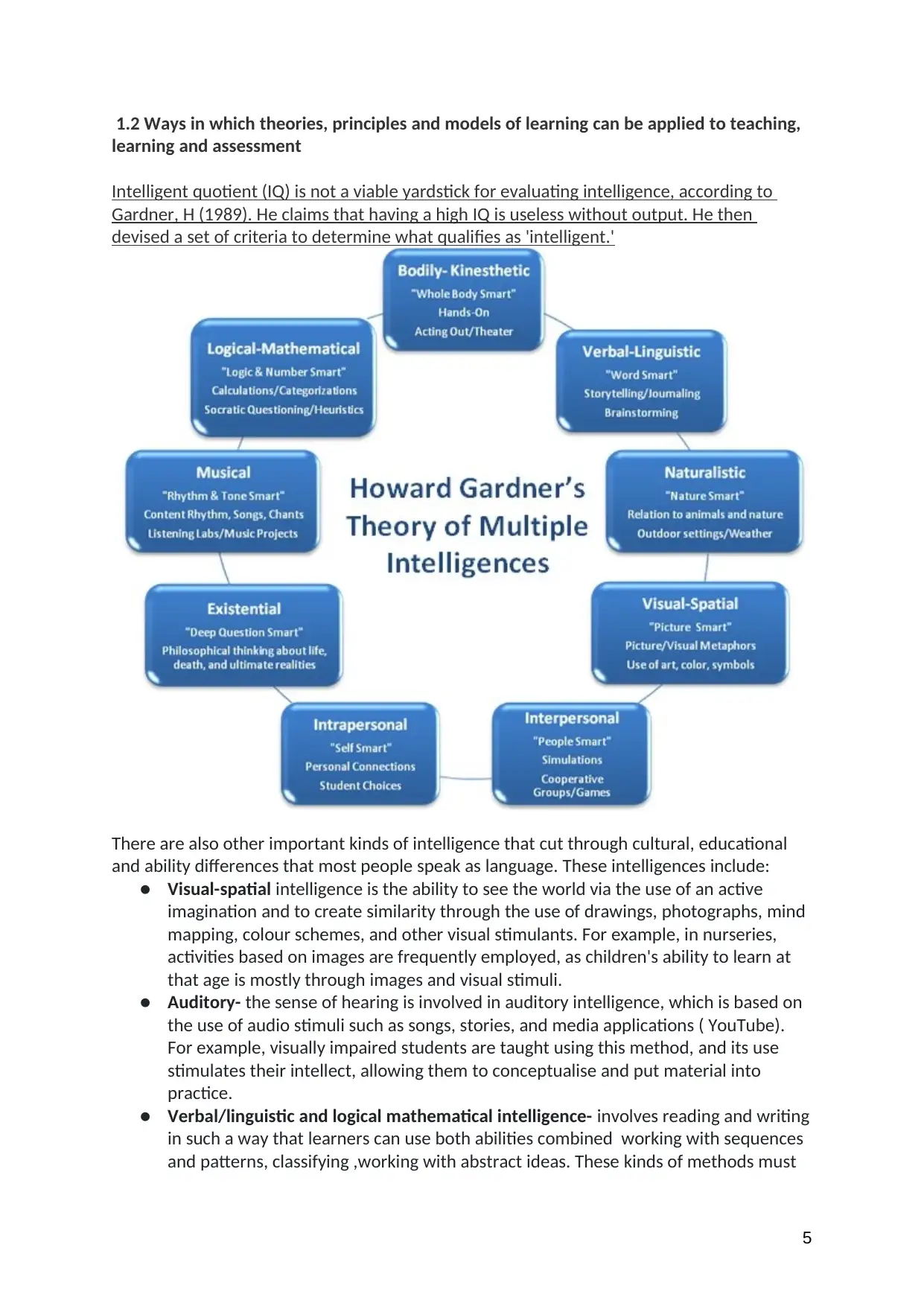
1.2 Ways in which theories, principles and models of learning can be applied to teaching,
learning and assessment
Intelligent quotient (IQ) is not a viable yardstick for evaluating intelligence, according to
Gardner, H (1989). He claims that having a high IQ is useless without output. He then
devised a set of criteria to determine what qualifies as 'intelligent.'
There are also other important kinds of intelligence that cut through cultural, educational
and ability differences that most people speak as language. These intelligences include:
● Visual-spatial intelligence is the ability to see the world via the use of an active
imagination and to create similarity through the use of drawings, photographs, mind
mapping, colour schemes, and other visual stimulants. For example, in nurseries,
activities based on images are frequently employed, as children's ability to learn at
that age is mostly through images and visual stimuli.
● Auditory- the sense of hearing is involved in auditory intelligence, which is based on
the use of audio stimuli such as songs, stories, and media applications ( YouTube).
For example, visually impaired students are taught using this method, and its use
stimulates their intellect, allowing them to conceptualise and put material into
practice.
● Verbal/linguistic and logical mathematical intelligence- involves reading and writing
in such a way that learners can use both abilities combined working with sequences
and patterns, classifying ,working with abstract ideas. These kinds of methods must
5
learning and assessment
Intelligent quotient (IQ) is not a viable yardstick for evaluating intelligence, according to
Gardner, H (1989). He claims that having a high IQ is useless without output. He then
devised a set of criteria to determine what qualifies as 'intelligent.'
There are also other important kinds of intelligence that cut through cultural, educational
and ability differences that most people speak as language. These intelligences include:
● Visual-spatial intelligence is the ability to see the world via the use of an active
imagination and to create similarity through the use of drawings, photographs, mind
mapping, colour schemes, and other visual stimulants. For example, in nurseries,
activities based on images are frequently employed, as children's ability to learn at
that age is mostly through images and visual stimuli.
● Auditory- the sense of hearing is involved in auditory intelligence, which is based on
the use of audio stimuli such as songs, stories, and media applications ( YouTube).
For example, visually impaired students are taught using this method, and its use
stimulates their intellect, allowing them to conceptualise and put material into
practice.
● Verbal/linguistic and logical mathematical intelligence- involves reading and writing
in such a way that learners can use both abilities combined working with sequences
and patterns, classifying ,working with abstract ideas. These kinds of methods must
5
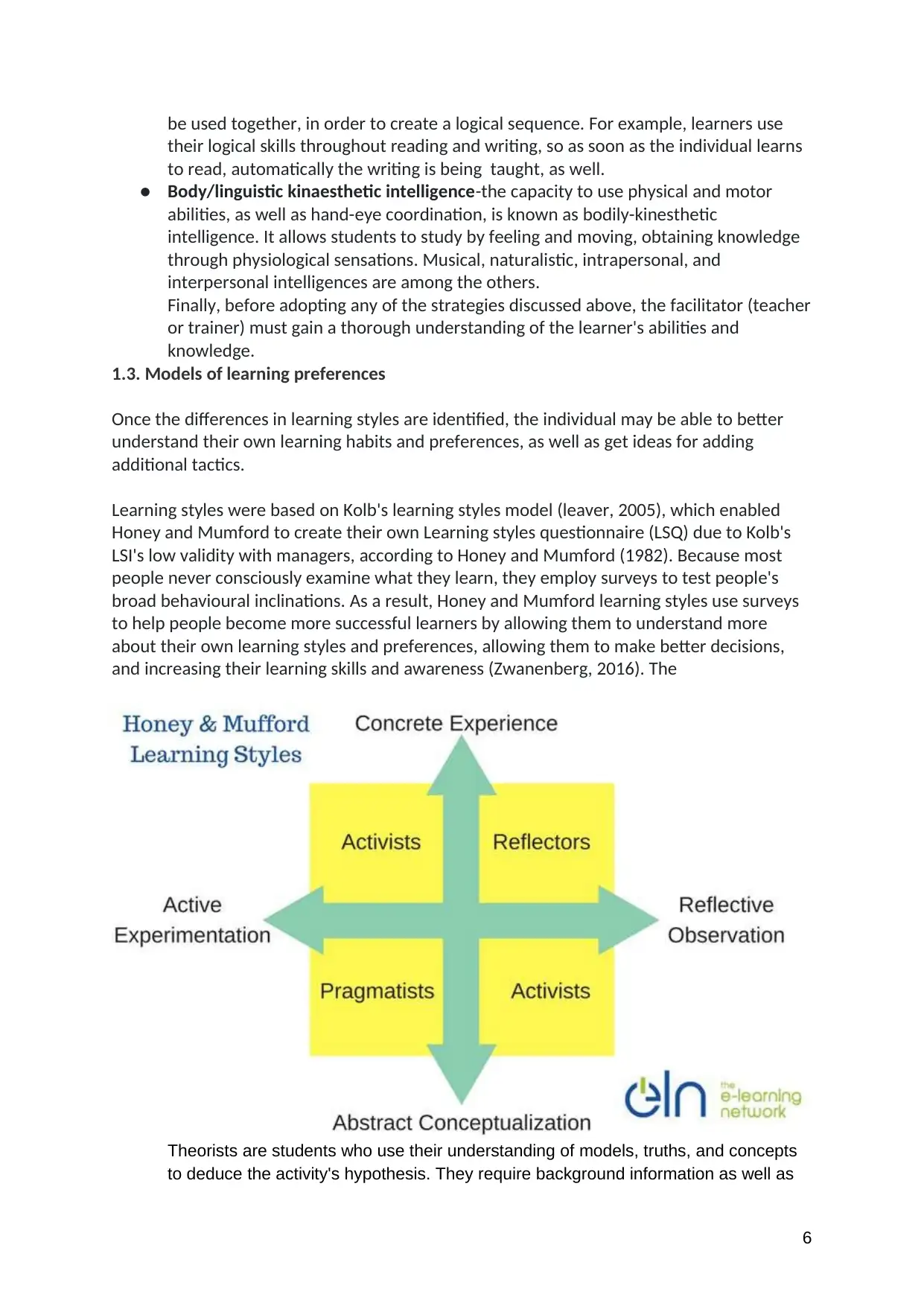
be used together, in order to create a logical sequence. For example, learners use
their logical skills throughout reading and writing, so as soon as the individual learns
to read, automatically the writing is being taught, as well.
● Body/linguistic kinaesthetic intelligence-the capacity to use physical and motor
abilities, as well as hand-eye coordination, is known as bodily-kinesthetic
intelligence. It allows students to study by feeling and moving, obtaining knowledge
through physiological sensations. Musical, naturalistic, intrapersonal, and
interpersonal intelligences are among the others.
Finally, before adopting any of the strategies discussed above, the facilitator (teacher
or trainer) must gain a thorough understanding of the learner's abilities and
knowledge.
1.3. Models of learning preferences
Once the differences in learning styles are identified, the individual may be able to better
understand their own learning habits and preferences, as well as get ideas for adding
additional tactics.
Learning styles were based on Kolb's learning styles model (leaver, 2005), which enabled
Honey and Mumford to create their own Learning styles questionnaire (LSQ) due to Kolb's
LSI's low validity with managers, according to Honey and Mumford (1982). Because most
people never consciously examine what they learn, they employ surveys to test people's
broad behavioural inclinations. As a result, Honey and Mumford learning styles use surveys
to help people become more successful learners by allowing them to understand more
about their own learning styles and preferences, allowing them to make better decisions,
and increasing their learning skills and awareness (Zwanenberg, 2016). The
Theorists are students who use their understanding of models, truths, and concepts
to deduce the activity's hypothesis. They require background information as well as
6
their logical skills throughout reading and writing, so as soon as the individual learns
to read, automatically the writing is being taught, as well.
● Body/linguistic kinaesthetic intelligence-the capacity to use physical and motor
abilities, as well as hand-eye coordination, is known as bodily-kinesthetic
intelligence. It allows students to study by feeling and moving, obtaining knowledge
through physiological sensations. Musical, naturalistic, intrapersonal, and
interpersonal intelligences are among the others.
Finally, before adopting any of the strategies discussed above, the facilitator (teacher
or trainer) must gain a thorough understanding of the learner's abilities and
knowledge.
1.3. Models of learning preferences
Once the differences in learning styles are identified, the individual may be able to better
understand their own learning habits and preferences, as well as get ideas for adding
additional tactics.
Learning styles were based on Kolb's learning styles model (leaver, 2005), which enabled
Honey and Mumford to create their own Learning styles questionnaire (LSQ) due to Kolb's
LSI's low validity with managers, according to Honey and Mumford (1982). Because most
people never consciously examine what they learn, they employ surveys to test people's
broad behavioural inclinations. As a result, Honey and Mumford learning styles use surveys
to help people become more successful learners by allowing them to understand more
about their own learning styles and preferences, allowing them to make better decisions,
and increasing their learning skills and awareness (Zwanenberg, 2016). The
Theorists are students who use their understanding of models, truths, and concepts
to deduce the activity's hypothesis. They require background information as well as
6
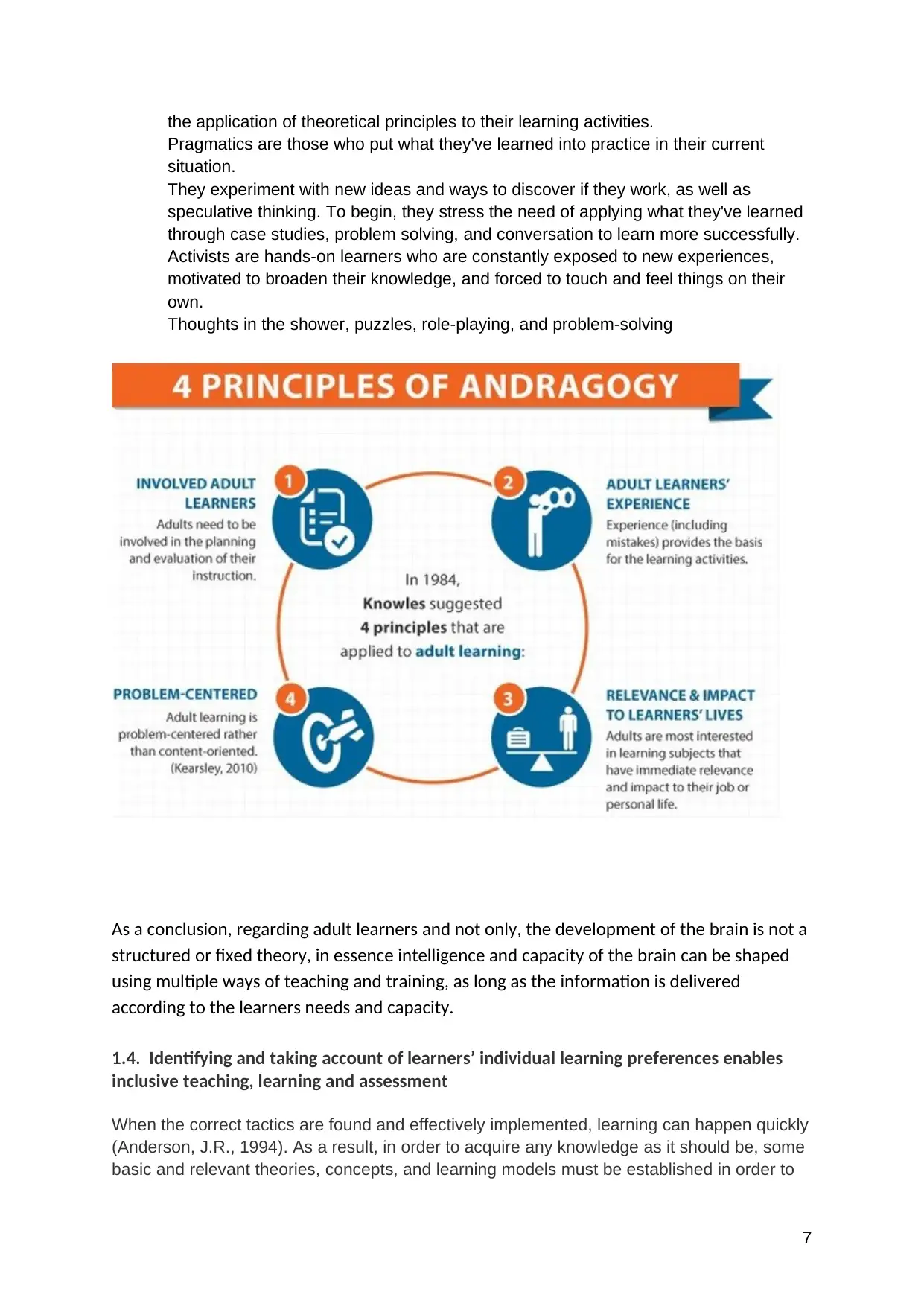
the application of theoretical principles to their learning activities.
Pragmatics are those who put what they've learned into practice in their current
situation.
They experiment with new ideas and ways to discover if they work, as well as
speculative thinking. To begin, they stress the need of applying what they've learned
through case studies, problem solving, and conversation to learn more successfully.
Activists are hands-on learners who are constantly exposed to new experiences,
motivated to broaden their knowledge, and forced to touch and feel things on their
own.
Thoughts in the shower, puzzles, role-playing, and problem-solving
As a conclusion, regarding adult learners and not only, the development of the brain is not a
structured or fixed theory, in essence intelligence and capacity of the brain can be shaped
using multiple ways of teaching and training, as long as the information is delivered
according to the learners needs and capacity.
1.4. Identifying and taking account of learners’ individual learning preferences enables
inclusive teaching, learning and assessment
When the correct tactics are found and effectively implemented, learning can happen quickly
(Anderson, J.R., 1994). As a result, in order to acquire any knowledge as it should be, some
basic and relevant theories, concepts, and learning models must be established in order to
7
Pragmatics are those who put what they've learned into practice in their current
situation.
They experiment with new ideas and ways to discover if they work, as well as
speculative thinking. To begin, they stress the need of applying what they've learned
through case studies, problem solving, and conversation to learn more successfully.
Activists are hands-on learners who are constantly exposed to new experiences,
motivated to broaden their knowledge, and forced to touch and feel things on their
own.
Thoughts in the shower, puzzles, role-playing, and problem-solving
As a conclusion, regarding adult learners and not only, the development of the brain is not a
structured or fixed theory, in essence intelligence and capacity of the brain can be shaped
using multiple ways of teaching and training, as long as the information is delivered
according to the learners needs and capacity.
1.4. Identifying and taking account of learners’ individual learning preferences enables
inclusive teaching, learning and assessment
When the correct tactics are found and effectively implemented, learning can happen quickly
(Anderson, J.R., 1994). As a result, in order to acquire any knowledge as it should be, some
basic and relevant theories, concepts, and learning models must be established in order to
7
Paraphrase This Document
Need a fresh take? Get an instant paraphrase of this document with our AI Paraphraser
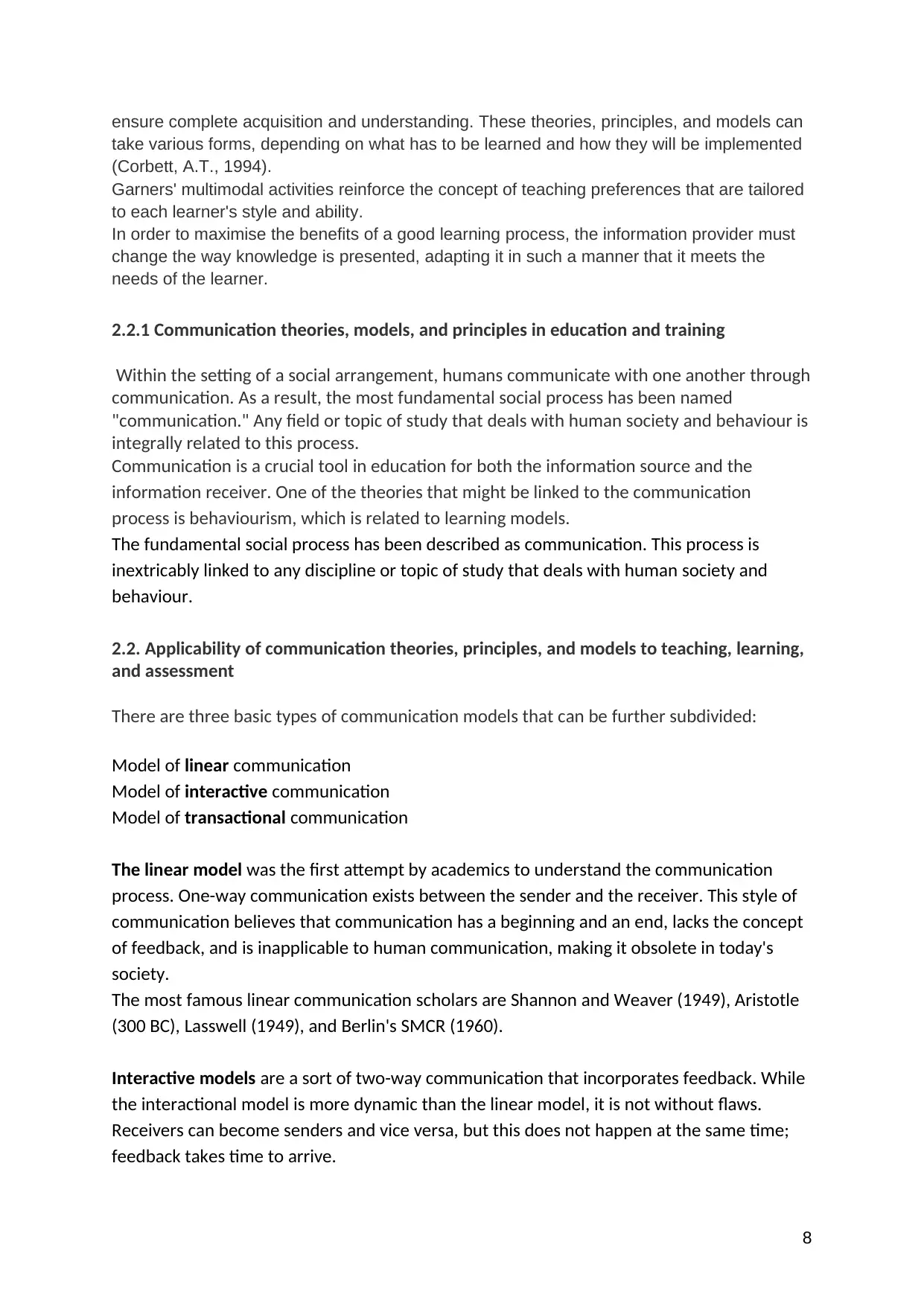
ensure complete acquisition and understanding. These theories, principles, and models can
take various forms, depending on what has to be learned and how they will be implemented
(Corbett, A.T., 1994).
Garners' multimodal activities reinforce the concept of teaching preferences that are tailored
to each learner's style and ability.
In order to maximise the benefits of a good learning process, the information provider must
change the way knowledge is presented, adapting it in such a manner that it meets the
needs of the learner.
2.2.1 Communication theories, models, and principles in education and training
Within the setting of a social arrangement, humans communicate with one another through
communication. As a result, the most fundamental social process has been named
"communication." Any field or topic of study that deals with human society and behaviour is
integrally related to this process.
Communication is a crucial tool in education for both the information source and the
information receiver. One of the theories that might be linked to the communication
process is behaviourism, which is related to learning models.
The fundamental social process has been described as communication. This process is
inextricably linked to any discipline or topic of study that deals with human society and
behaviour.
2.2. Applicability of communication theories, principles, and models to teaching, learning,
and assessment
There are three basic types of communication models that can be further subdivided:
Model of linear communication
Model of interactive communication
Model of transactional communication
The linear model was the first attempt by academics to understand the communication
process. One-way communication exists between the sender and the receiver. This style of
communication believes that communication has a beginning and an end, lacks the concept
of feedback, and is inapplicable to human communication, making it obsolete in today's
society.
The most famous linear communication scholars are Shannon and Weaver (1949), Aristotle
(300 BC), Lasswell (1949), and Berlin's SMCR (1960).
Interactive models are a sort of two-way communication that incorporates feedback. While
the interactional model is more dynamic than the linear model, it is not without flaws.
Receivers can become senders and vice versa, but this does not happen at the same time;
feedback takes time to arrive.
8
take various forms, depending on what has to be learned and how they will be implemented
(Corbett, A.T., 1994).
Garners' multimodal activities reinforce the concept of teaching preferences that are tailored
to each learner's style and ability.
In order to maximise the benefits of a good learning process, the information provider must
change the way knowledge is presented, adapting it in such a manner that it meets the
needs of the learner.
2.2.1 Communication theories, models, and principles in education and training
Within the setting of a social arrangement, humans communicate with one another through
communication. As a result, the most fundamental social process has been named
"communication." Any field or topic of study that deals with human society and behaviour is
integrally related to this process.
Communication is a crucial tool in education for both the information source and the
information receiver. One of the theories that might be linked to the communication
process is behaviourism, which is related to learning models.
The fundamental social process has been described as communication. This process is
inextricably linked to any discipline or topic of study that deals with human society and
behaviour.
2.2. Applicability of communication theories, principles, and models to teaching, learning,
and assessment
There are three basic types of communication models that can be further subdivided:
Model of linear communication
Model of interactive communication
Model of transactional communication
The linear model was the first attempt by academics to understand the communication
process. One-way communication exists between the sender and the receiver. This style of
communication believes that communication has a beginning and an end, lacks the concept
of feedback, and is inapplicable to human communication, making it obsolete in today's
society.
The most famous linear communication scholars are Shannon and Weaver (1949), Aristotle
(300 BC), Lasswell (1949), and Berlin's SMCR (1960).
Interactive models are a sort of two-way communication that incorporates feedback. While
the interactional model is more dynamic than the linear model, it is not without flaws.
Receivers can become senders and vice versa, but this does not happen at the same time;
feedback takes time to arrive.
8
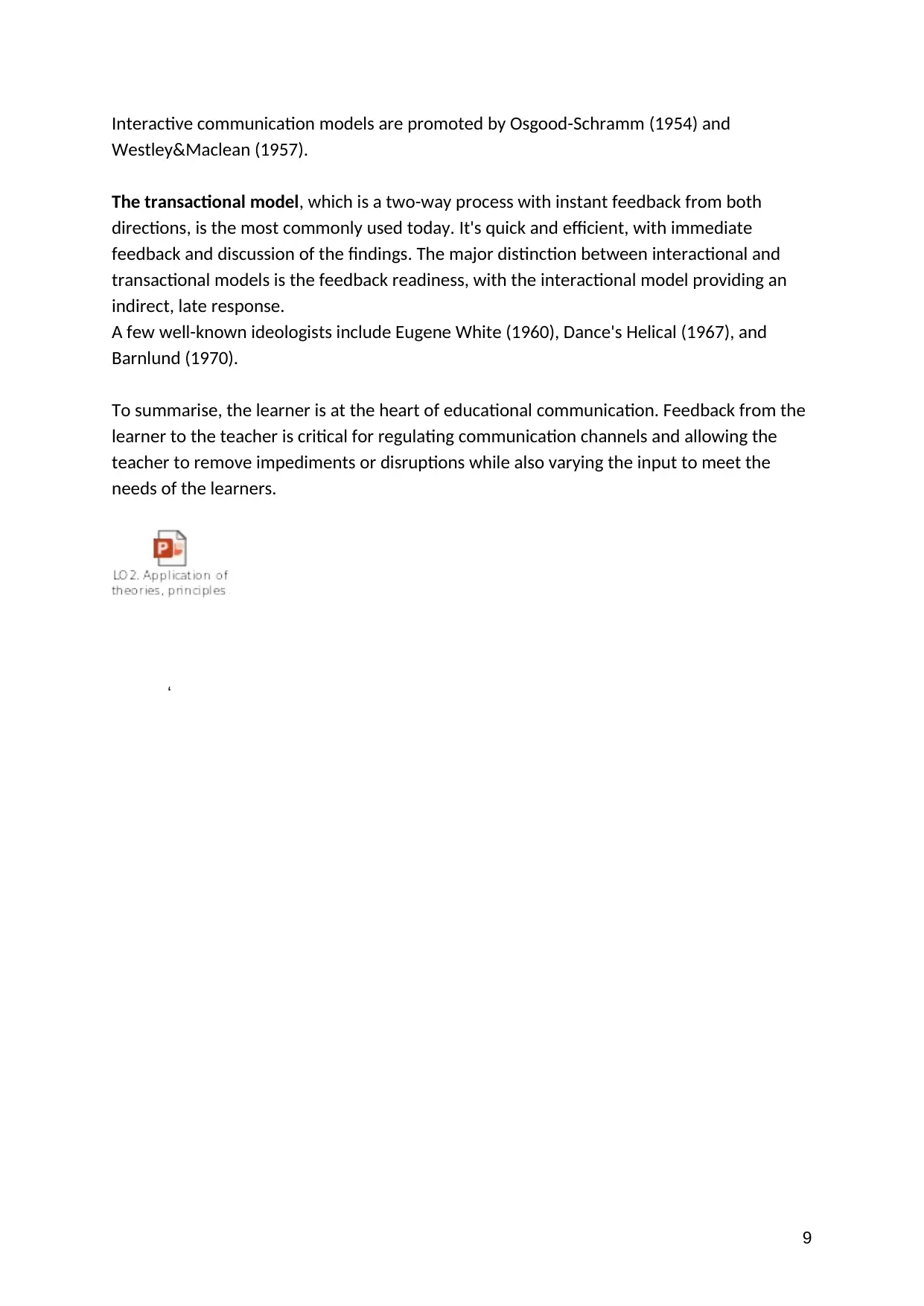
Interactive communication models are promoted by Osgood-Schramm (1954) and
Westley&Maclean (1957).
The transactional model, which is a two-way process with instant feedback from both
directions, is the most commonly used today. It's quick and efficient, with immediate
feedback and discussion of the findings. The major distinction between interactional and
transactional models is the feedback readiness, with the interactional model providing an
indirect, late response.
A few well-known ideologists include Eugene White (1960), Dance's Helical (1967), and
Barnlund (1970).
To summarise, the learner is at the heart of educational communication. Feedback from the
learner to the teacher is critical for regulating communication channels and allowing the
teacher to remove impediments or disruptions while also varying the input to meet the
needs of the learners.
‘
”
”
9
Westley&Maclean (1957).
The transactional model, which is a two-way process with instant feedback from both
directions, is the most commonly used today. It's quick and efficient, with immediate
feedback and discussion of the findings. The major distinction between interactional and
transactional models is the feedback readiness, with the interactional model providing an
indirect, late response.
A few well-known ideologists include Eugene White (1960), Dance's Helical (1967), and
Barnlund (1970).
To summarise, the learner is at the heart of educational communication. Feedback from the
learner to the teacher is critical for regulating communication channels and allowing the
teacher to remove impediments or disruptions while also varying the input to meet the
needs of the learners.
‘
”
”
9
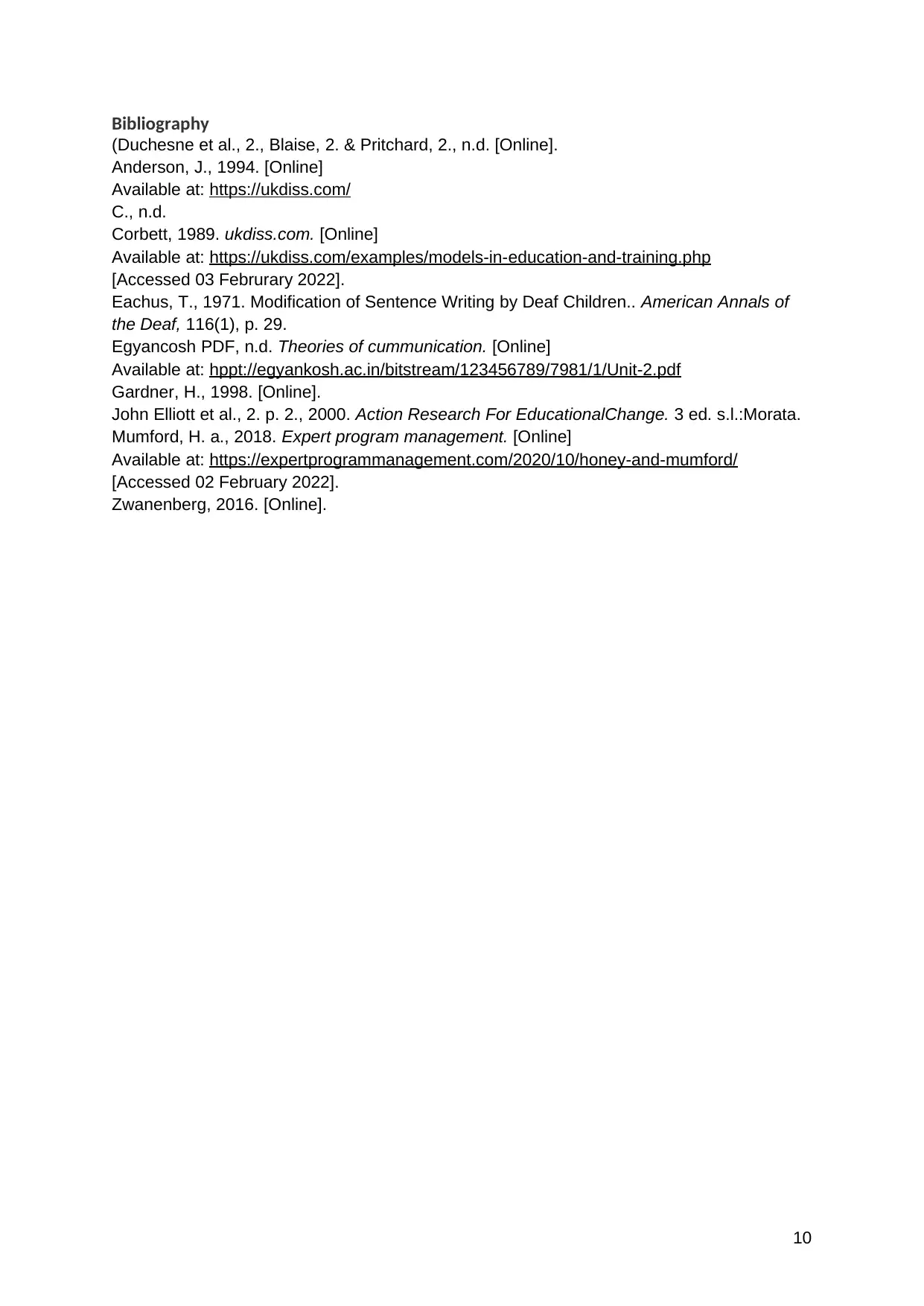
Bibliography
(Duchesne et al., 2., Blaise, 2. & Pritchard, 2., n.d. [Online].
Anderson, J., 1994. [Online]
Available at: https://ukdiss.com/
C., n.d.
Corbett, 1989. ukdiss.com. [Online]
Available at: https://ukdiss.com/examples/models-in-education-and-training.php
[Accessed 03 Februrary 2022].
Eachus, T., 1971. Modification of Sentence Writing by Deaf Children.. American Annals of
the Deaf, 116(1), p. 29.
Egyancosh PDF, n.d. Theories of cummunication. [Online]
Available at: hppt://egyankosh.ac.in/bitstream/123456789/7981/1/Unit-2.pdf
Gardner, H., 1998. [Online].
John Elliott et al., 2. p. 2., 2000. Action Research For EducationalChange. 3 ed. s.l.:Morata.
Mumford, H. a., 2018. Expert program management. [Online]
Available at: https://expertprogrammanagement.com/2020/10/honey-and-mumford/
[Accessed 02 February 2022].
Zwanenberg, 2016. [Online].
10
(Duchesne et al., 2., Blaise, 2. & Pritchard, 2., n.d. [Online].
Anderson, J., 1994. [Online]
Available at: https://ukdiss.com/
C., n.d.
Corbett, 1989. ukdiss.com. [Online]
Available at: https://ukdiss.com/examples/models-in-education-and-training.php
[Accessed 03 Februrary 2022].
Eachus, T., 1971. Modification of Sentence Writing by Deaf Children.. American Annals of
the Deaf, 116(1), p. 29.
Egyancosh PDF, n.d. Theories of cummunication. [Online]
Available at: hppt://egyankosh.ac.in/bitstream/123456789/7981/1/Unit-2.pdf
Gardner, H., 1998. [Online].
John Elliott et al., 2. p. 2., 2000. Action Research For EducationalChange. 3 ed. s.l.:Morata.
Mumford, H. a., 2018. Expert program management. [Online]
Available at: https://expertprogrammanagement.com/2020/10/honey-and-mumford/
[Accessed 02 February 2022].
Zwanenberg, 2016. [Online].
10
1 out of 10
Related Documents
Your All-in-One AI-Powered Toolkit for Academic Success.
+13062052269
info@desklib.com
Available 24*7 on WhatsApp / Email
![[object Object]](/_next/static/media/star-bottom.7253800d.svg)
Unlock your academic potential
© 2024 | Zucol Services PVT LTD | All rights reserved.


